How to Do a Multi-Day Run on the Tour du Mont-Blanc Trail

Running along the Tour du Mont Blanc loop. (Photo: Sam Hill)
Three countries. Glacier-filled views. High alpine pastures, and all of it along the course of the world’s most famous trail race. If there is one place in the world to do a multi-day trail running trip, it’s the Tour du Mont-Blanc.
From mid-June through late September, a burgeoning number of trail runners are flocking to this route long beloved by hikers from around the world. The Tour du Mont-Blanc (TMB) has become trail running’s de facto pilgrimage. And for good reason.
Starting in the hyperactive mountain town of Chamonix, France at the base of 15,780-foot Mont Blanc, the 100-mile TMB loop is one of the oldest continuous foot paths in the world. The list of glowing adjectives and superlatives reads like hackneyed tourist office boilerplate: high alpine meadows ringing with cow bells, soaring peaks, French, Italian, and English mixing in the air at cozy mountain huts as bowls of polenta with fresh, local fontina cheese as dished out by the resident guardians, or caretakers.
Running the TMB over the course of four to eight days is as dreamy as it sounds—with the right preparation.
Similar Reads
RELATED: Why Chamonix Is the Center of the Trail Running Universe
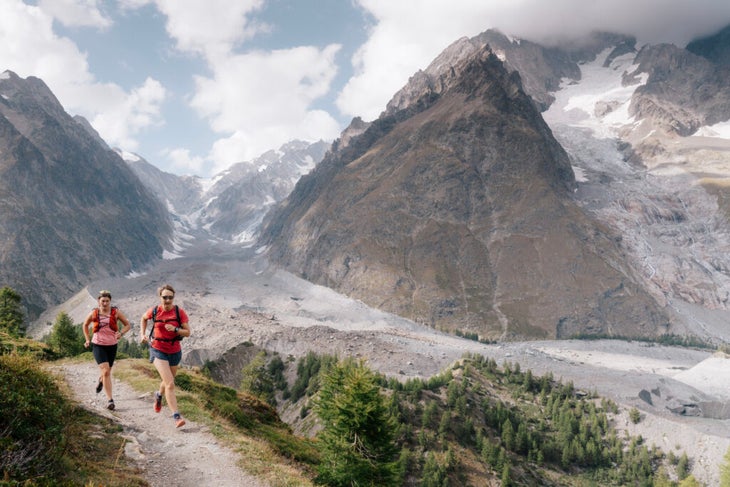
In the Footsteps of Ultrarunning Legends
The rise of trail running on one of the world’s most iconic multi day hikes parallels, logically, the ultra trail race that borrows its name, UTMB. (Now UTMB du Mont-Blanc so as to not be confused with the 44 other races in the UTMB World Series.) That race’s history goes back to the fall of 2002, when after a not-insignificant amount of prodding from René Bachelard, then the head of Chamonix’s running club, CMBM, a group of volunteers met at the Hotel Faucigny and created a daring, no-holes-barred, non-stop race around the range, which that first year was known as The North Face International Ultra-Trail du Mont-Blanc.
We all know the spectacle it’s transformed into in those ensuing 22 years. Fortunately, you don’t have to run the loop around “Le Mont Blanc” in 19:37:43, as American Jim Walmsley did en route to winning UTMB last year. In fact, running the Tour du Mont-Blanc can be downright leisurely. Villages are nicely spaced, roughly 10 to 20 miles apart, to make for a 6-day tour with 14-21 or so miles and 3,000- to 6,000 feet of climbing each day.
Chamonix is 90 minutes from the Geneva Airport, with a half dozen or more services happy to shuttle you there. And if you use the same hotel for the start and finish, you can usually leave a few bags in storage for no additional fee.
Choices, Choices
Before you dive into planning, you’ve got a few key choices to make. The TMB breaks logically into a six-day trip, because of the spacing of villages on the route. But if you’re feeling badass and have a headlamp at the ready, consider doubling up for big days out. If it’s your first time on the route, however, be forewarned: the scent of warm croissants can be kryptonite for your Strava times. Consider the more leisurely itinerary, and you’ll get to take in the views and the calories en route. (See the chart below for a typical breakout.)
Next, decide your style. One of the real delights of the route is that thanks to luggage transport services around the mountain, you can run all day with just the essentials, show up at your hotel, and grab your duffel filled with town clothes, your iPad, foam roller, favorite treats and, well, you name it. Or you can save a few euros and fastpack the route. Just don’t be too mopey when Les Traileurs run past toting 12 liters instead of 25.
Next, pick your route. While the TMB is an obvious, heavily traveled loop, options—called variants—abound. For a full list of options, see this summary of common variants to make the route both longer and shorter. Our favorite? The high, wild climb over Fenetre d’Arpette. It’s dramatic and rugged, with an exciting top-out at the col, with a scrambly descent in places. And, oh, it ends at Buvette du Glacier with plenty of regional treats. (I recommend the tarte aux pêches.)
RELATED: Read More of RUN’s Stories about UTMB and Chamonix
How to Run the TMB
Planning a trip around the range used to be a simple matter of dashing off emails to village hotels and mountain cabins. But with growing numbers on the route, users are confronting a variety of new challenges, on and off the trail.
On the trail, as the saying goes, timing is everything. Default to the standard hours for breakfast, and you might find yourself in the midst of a pole-clanging TMB conga line of international hikers, walkers, and trail runners. Roll out from under the duvet early, however, and you’ll have quiet trails and can avoid a long mid-day wait for croute au fromage at the refuges. Consider TMB variants to keep numbers down. Only diehards who aspire to race UTMB du Mont-Blanc one day will stick to the course. Let me explain why.
Off the trail, mostly gone are the days of booking a hotel a few months before your trip. Hotels are jammed with requests, and many now take reservations much earlier—often a year or more in advance, with exact dates varying with each hotel. There are “pinch points,” too, locations like Trient, Switzerland, where you’re looking at some taxi times ranging from 15 to 45 minutes to reach a bigger town with more capacity. Rooms come and go, based on when tour operators come up against dates when reservations become non-refundable.
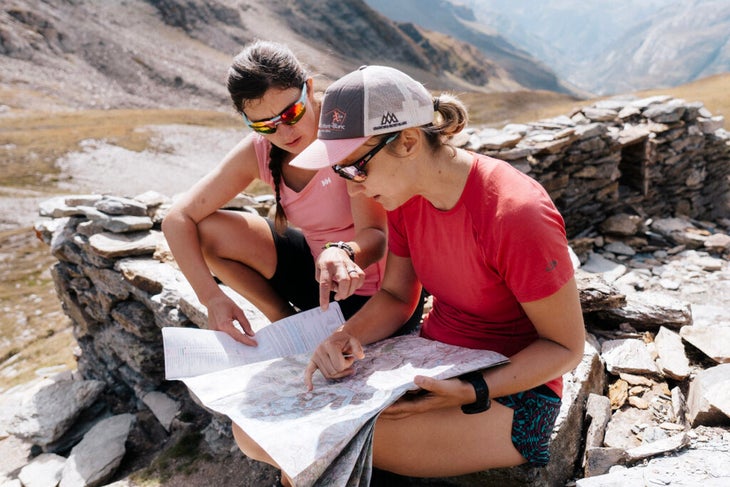
Baggage transport services only pickup and deliver to partner hotels. Both paying and cancellation terms are a hodge-podge, varying from one business to another. If you like Google Sheets and have time to play, you’ll like the puzzle. If you don’t, well, Google has another answer: search for “TMB Trail Running Vacation Tour Companies.”
Much of those trials and tribulations can be mitigated by eyeing the shoulder seasons of early June or mid-September. But you will be trading quieter trails and less-stressed hoteliers for potentially tricky trail and weather conditions. After a big spring of snow this year, some early bird trail runners found themselves on more snow than trail, with the consequent risks of unplanned slides down steep snowfields, crevasses, and snowbridges undermined with rushing water.
And the weather in the Alps deserves your attention, especially during June and September. While the trail elevation isn’t as lofty as other big mountain ranges—the year-round snow and glaciers are mostly above about 3,000 meters (9,850 feet)—wintry storms can land any month of the year, and unprepared travelers at the wrong place at the wrong time can quickly become a statistic. When I raced Ultra-Trail du Mont-Blanc in 2017, crossing that year’s high point at 8,323-foot high Grand Col Ferret felt more like Fairbanks, Alaska, than Ferret, Switzerland. On race safety detail, my friend Federico Gilardi greeted me in a one-piece down suit, bear-hugged me, and yelled for me to start running down right away. (Sleet turned to rain turned to clouds over the ensuing half hour.)
RELATED: Book Review—”The Race That Changed Running: The Inside Story of UTMB”
Protecting This Place We Love to Play
There is one big, juicy caveat to trail running the TMB. In Chamonix, this summer, the mot-du-jour is surtourisme, overtourism. During busy weekends mid-summer, the route is just plain packed. Busses up Italy’s Val Ferret will conjure up images of the professional packers who work Tokyo’s subways. You will never look ahead and see an empty singletrack, and a lunch hour with one of the world’s best views will snake out of the entrance to Refugio Bonatti.
Last year, a video filmed by a local hiking guide showed dozens of trekkers leaving the village of Les Contamines, France, for their day on the TMB. It went viral, spurring on discussion of how to manage burgeoning numbers. There are no easy solutions. Unlike, say, California’s 211-mile long John Muir Trail, the TMB has dozens if not hundreds of access points. In place of one country and a few federal agencies, there are three countries, 18 municipalities, and only-God-knows how many agencies are involved in managing the route.
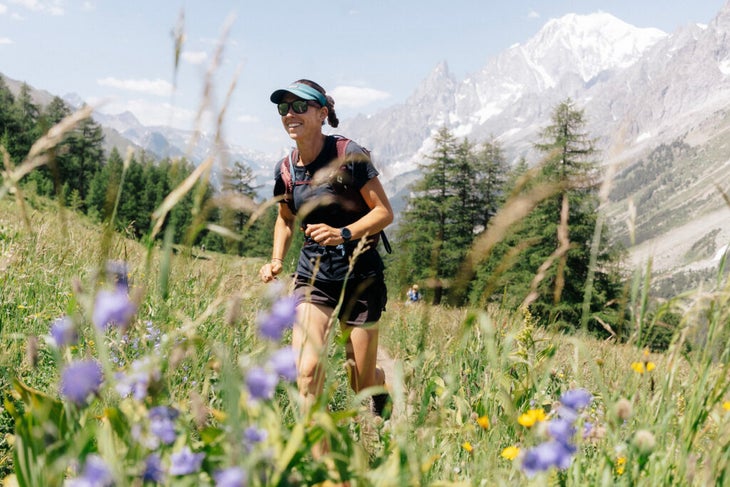
“I like to think of the TMB as a pilgrimage, in part because it’s awe-inspiring and also because of how many people are doing it. When you hike or run the TMB, you’re not alone. If you embrace it, that can be part of the fun,” says Troy Haines, the owner of US-based hiking tour company Alpinehikers. “The TMB is not the place to ‘get away from it all.’ Years ago, there were quiet corners, but not now. Every year there are more and more people who want to come, but still just the few same inns in the more remote valleys. You might not notice it when you’re on the TMB, but you do notice the difference if you go to other regions, where the energy is much more relaxed.”
Fortunately, there are things you can do to reduce your impact. Start by brushing up on the seven LNT principles, and then apply them to the TMB. Before you go, read up on local regulations, which vary between countries, and often within them as well, as the trail passes through several protected alpine areas. (For example: swimming is not allowed in alpine tarns, where sunscreen can alter the pH of the water.)
In terms of physical impact, a few examples include traveling in a small group (the smaller the better), staying on the trail, cleaning up “micro-litter” as you go, and using established facilities that can handle your impact instead of “wild” camping. Culturally, it’s thoughtful to learn a few key phrases in French and Italian, and learn the local etiquette on the trail and at mountain huts. There’s plenty more, of course. Two good places to start are the Chamoniard, an association devoted to disseminating mountain information, and Autour du Mont Blanc, the official web site for the trail. Feeling overwhelmed? Hiring a reputable tour company is one way to quickly address these concerns.
And before, during and after your trip, support the non-profit groups that are on the front lines working to protect both the resource and the experience. Hillary Gerardi, a Black Diamond-sponsored trail runner who lives in the Chamonix Valley, has worked for one of those groups: CREA-Mont Blanc, a science-focused nonprofit that studies the alpine ecosystem. She suggests donating to that organization, as well as Mountain Wilderness, whose goal is to protect wild mountain regions, or Inspire, which works to improve air quality in the region. In Switzerland, Gil Caillet-Bois, the Race Director for Trail Dents-du-Midi, the oldest trail race in the Alps, suggests supporting Summit Foundation, whose mission is to reduce environmental impacts in heavily trafficked alpine areas. Over in Italy, the Foundation Monagna Sicura carries out alpine research and supports sustainable development initiatives.
“The nonprofits that work here are tuned into the impacts of climate change, biodiversity loss, and overtourism,” Gerardi says. “There are a lot of different approaches, but personally I’m excited to see ones dedicated to helping people to understand what’s going on and how it is impacting them, whether through scientific research or informing them about ongoing challenges.”
Now, a late-in-the-game confession: I’m not a disinterested journalist on this topic. More than a decade ago, I started Run the Alps, a company that offers trail running tours. Serendipity and a career change brought me to Chamonix full-time six years ago. I can throw a baguette out my living room window and, if the wind is coming off the Le Tour glacier, it’ll land on the TMB.
RELATED: 8 Essential Tips for Trail-Running Travel
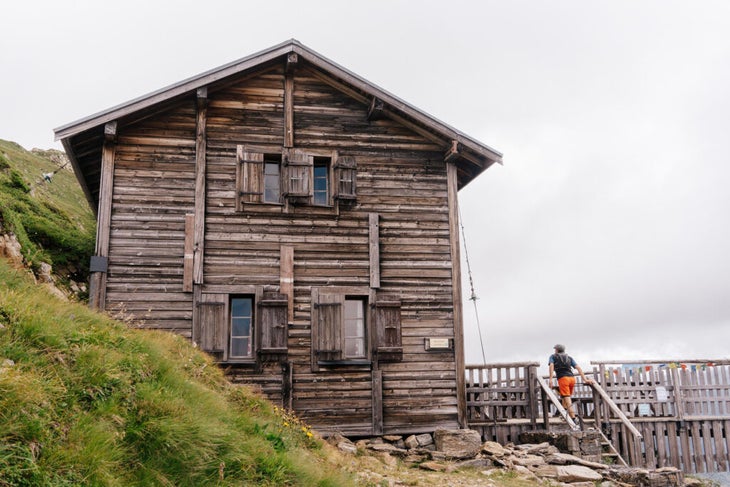
Run the Alps has adopted a statement of values that holds us to being a “net positive” company. So, the questions surrounding overuse on the TMB are something we think about nearly every day. Some answers are easy (hop on the rocks when you’re in a muddy paturage, please). Others, less so. (In an era of rapid climate change, is all tourist travel decadent? How much is too much?) We’ve created LNT guidelines for all our trips, and on the TMB our standard groups are no more than seven guests and one guide. As of this summer, we’ve developed a 30 page internal handbook for our guides which highlights interpretive tips they can share with our guests.
Overuse of wild lands is hardly unique to the TMB, of course. And slipping into a running pack and running to high mountain huts through three countries is still as dreamy as it sounds. Time your visit right (hint: the first three weeks of August) and the likes of Katie Schide or Jim Walmsley just might float past you on the trail.
Many years ago, I was atop Grand Col Ferret, one foot in Italy and the other in Switzerland, when a wild-eyed, sunburned trail runner powered by, toting a heavy-looking fast pack. It was Colorado’s Zach Miller, who that August was doing his best Tazmanian Devil impersonation, whipping around the Mont Blanc range, lap after lap, bivvying as he went. When it comes to trail running, the TMB is full of surprises.
And as for René Bachelard, the man who inspired it all? Happily, he’s still here in Chamonix, and he’s even on Strava, though his account has been quiet recently. If you’re lucky enough to take in trail running’s Super Bowl during the last week of August, keep your eyes open for a thin, sporty-looking nonagenarian meandering along Chamonix’s pedestrian-friendly Rue du Dr. Paccard. Should you spy him, I’d just ask that you nod politely in thanks for that one day in 2002 when he twisted arms and talked a small group of traileurs into diving headfirst into what seemed at the time a downright audacious idea.
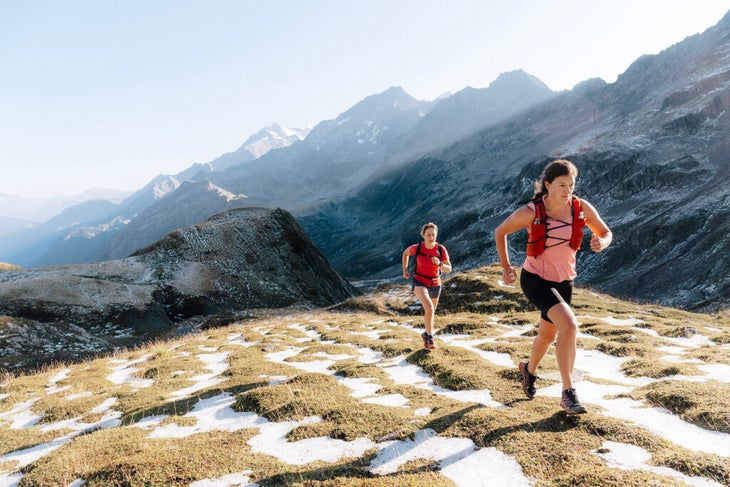
RELATED: Hiking the Tour du Mont Blanc: A Beginner’s Guide
A Typical Daily Breakout of a Run Around the TMB
Day 1: Chamonix to Les Contamines via Col Tricot
22.5K (14 miles), 1380 meters (4,530 feet) ascent, 1,260 meters (4,130 Feet) descent
Day 2: Les Contamines to Les Mottets
26K (16 miles), 1,620 meters (5,315 feet) ascent, 910m (2,990 feet) descent
Day 3: Les Mottets to Courmayeur, Italy
24kK (15 miles), 1,135 meters (3,730 feet) ascent, 1,640 meters (5,390 feet) descent
Day 4: Courmayeur, Italy to La Fouly, Switzerland
34K (21 miles), 1,370 meters (4,480 feet) ascent, 1,540 meters (5,040 feet) descent
Day 5: La Fouly to Trient
29K (18 miles), 1,160 meters (3,810 feet) ascent, 1,005 meters (3,300 feet) descent
Day 6: Trient to Chamonix, France via Chamonix valley
9K (18 miles), 1,720 meters (5,640 feet) ascent, 2,210 meters (7,250 feet) descent
Best big days out, combining the days above:
Les Contamines, France, to Courmayeur, Italy, roughly 31 miles
Courmayeur, Italy, to Champex-Lac, Switzerland, roughly 32 miles
Champex-Lac, Switzerland, to Chamonix, France, roughly 18 miles


